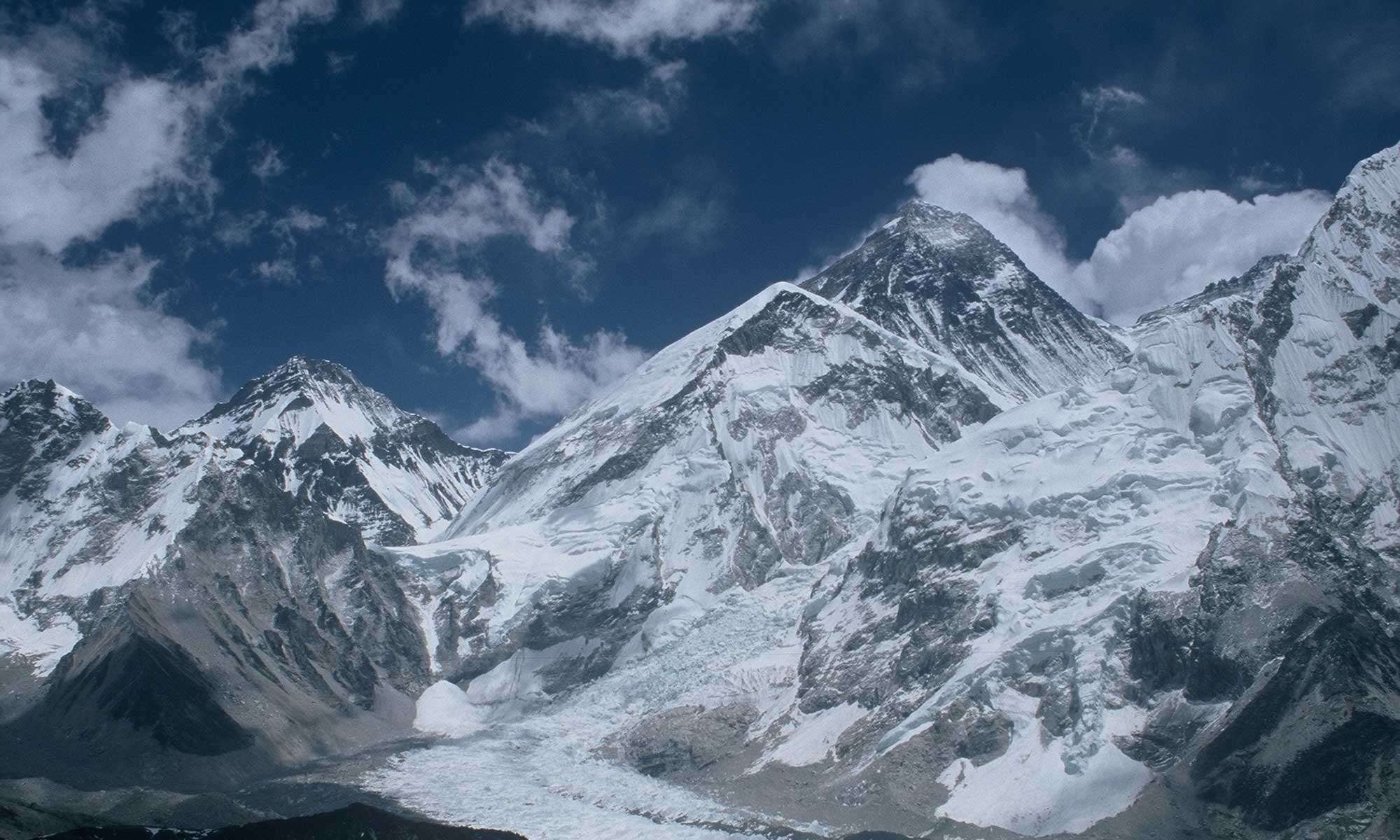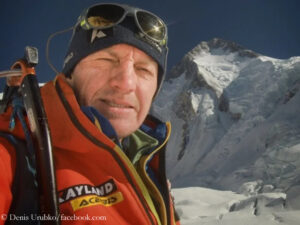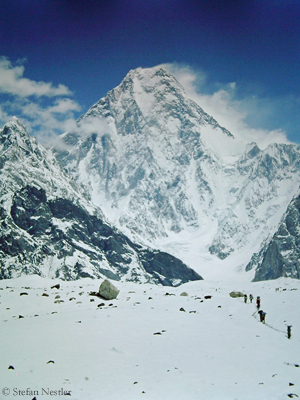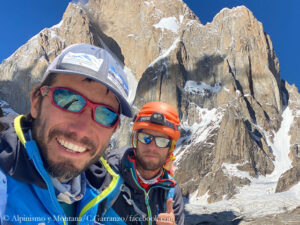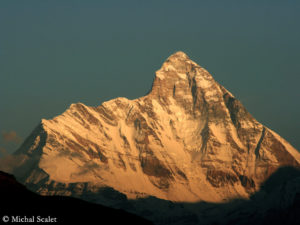It could have turned out worse. Denis Urubko wanted to climb up to Camp 2 at 6,400 meters on the eight-thousander Gasherbrum I in Pakistan at the weekend. However, at an altitude of 5,500 meters, Denis says he fell into a six to seven meter deep crevasse in the icefall. After an hour, his Pakistani climbing partner Hassan Shigri managed to help Urubko out of the crevasse. By this time, it had started to snow. “We spent a bad night and descended to base camp,” Urubko told the Spanish mountaineering portal desnivel.com. “I have frostbite on my fingers and can’t continue the expedition.” I’ll spare you the less than appetizing picture of his fingers. It shows that climbing is out of the question for Denis for the time being.
Continue reading “Urubko abandons Gasherbrum I winter expedition after crevasse fall”Winter expedition on Gasherbrum I: Denis Urubko crosses the icefall for the first time
After the Spaniard Alex Txikon and his companions on Annapurna I in western Nepal abandoned their expedition and returned home, Denis Urubko is the only remaining mountaineer still hoping for success on an eight-thousander this winter: on Gasherbrum I, also known as Hidden Peak, in the Karakoram in Pakistan.
Together with his Pakistani companion Hassan Shigri, the 50-year-old climbed through the icefall above the base camp towards Camp 1 (5,900 meters) and deposited equipment. Urubko reported to his partner, the Spanish climber Pipi Cardell, that he had had to break trail through a 30 to 80 centimeter high layer of snow. Denis plans to continue climbing alone from Camp 2 at around 6,400 meters.
Continue reading “Winter expedition on Gasherbrum I: Denis Urubko crosses the icefall for the first time”Annapurna winter expedition: rotation or summit attempt by Alex Txikon and Co.
The Spaniard Alex Txikon and his team set off from the base camp of Annapurna I this morning Nepalese local time. In strong winds, they reached Camp 1 at an altitude of around 5,000 meters. According to Txikon’s media team, they had to pause for an hour on the way due to a strong avalanche.
This is the climbers’ third so-called rotation on the eight-thousander in western Nepal. The main aim is to acclimatize further. On the last round a week ago, the team brought equipment up to Camp 3 at around 6,700 meters. Due to stormy gusts in the summit area, the climbers did not continue their ascent but returned to base camp.
Even before the new ascent, the team kept the possibility of a summit attempt open. “We’ll see the weather forecast,” said Italian Mattia Conte in a video posted on Instagram yesterday. “Slowly, slowly, without stress!” The winter weather is expected to be relatively calm over the next few days. After that, it should snow again.
Continue reading “Annapurna winter expedition: rotation or summit attempt by Alex Txikon and Co.”After drama on Gasherbrum IV: Mourning for Dmitry Golovchenko
The drama happened on 31 August, on Gasherbrum IV in Pakistan, at 7,684 meters, about 250 meters below the summit. Dmitry Golovchenko and Sergey Nilov had found a small spot on the ridge to pitch their tent for the night. The ground appeared problematic, broken rock covered with ice. The two Russians fixed the tent to a rope loop.
Very quickly, however, they realized that the ground was too sloped, and the tent was in danger of slipping. Sergey climbed out to level the platform and threw Dmitry a safety rope. A short time later, Sergey heard his friend call out, “Seryoga, I’m falling.” Nilov watched the tent with Golovchenko and their gear slide down the slope and disappear into the couloir below.
Continue reading “After drama on Gasherbrum IV: Mourning for Dmitry Golovchenko”Muhammad Hassan’s death on K2: Report renounces for blame
Could Muhammad Hassan still be alive today? The report of the commission of inquiry answers this question only indirectly: Yes, the father of three small children could still be alive if he had not been on K2, the second highest mountain in the world, located in Pakistan, on that 27 July. Because he simply didn’t belong there.
It was Hassan’s first eight-thousander expedition, according to the report of the five-member commission appointed by the regional government of Gilgit-Baltistan province after the death of the High Altitude Porter. Before that, Muhammad had only worked as a “Low Altitude Porter” on K2 (8,611 meters) and Spantik (7,027 meters), i.e. he had carried material to the base camps but not up the mountains.
Continue reading “Muhammad Hassan’s death on K2: Report renounces for blame”Drama on Gasherbrum IV
One of the most spectacular climbs this year probably ended in tragedy. Russian climber Dmitry Golovchenko did not return from the 7,932-meter-high Gasherbrum IV in the Karakoram in Pakistan. Golevchenko collapsed, mountain.ru reports. His rope partner Sergey Nilov returned alone to the base camp, it said adding that Nilov was severely weakened and had suffered frostbite.
What exactly happened to Golovchenko is still unclear. Apparently, however, he did not survive.
Continue reading “Drama on Gasherbrum IV”Miquel Mas and Marc Subirana open new route on Latok II secondary peak
The two Spanish climbers Miquel Mas and Marc Subirana succeeded in the second attempt a n alpinistic coup in the Karakoram. According to information from the Spaniard Carlos Garranzo, the two reached on Friday via a “very direct line” a previously unclimbed, approximately 6,400-meter-high secondary peak on the southwest flank of the 7,108-meter-high granite giant Latok II. They had spent a total of 18 days on the wall so far, with the summit day alone taking 14 hours, Carlos reports. According to him, Mique and Marc christened their new route “Latok Thumb.”
Mourning for Shinji Tamura
In the north of Pakistan, the search for the Japanese climber Shinji Tamura, well known in the high-altitude mountaineering scene, has been suspended. According to the Pakistani newspaper “Dawn”, Tamura, together with his compatriot Takayasu Semba, had attempted last week to scale an unclimbed almost 6,000-meter-high mountain in the Kande Valley in alpine style (without bottled oxygen, high altitude porters, high camps and fixed ropes).
At 5,300 meters, the two Japanese fell, the newspaper reports. Takayasu, who was only slightly injured, pitched a tent for his more seriously injured rope partner and descended to base camp to get help. However, a rescue team later failed to find Shinji. It is speculated that Tamura eventually tried to descend alone, possibly falling into a crevasse.
Continue reading “Mourning for Shinji Tamura”Willi Steindl on the lack of a rescue operation for Muhammad Hassan on K2: “You just have to want it”
The death of the Pakistani High Altitude Porter Muhammad Hassan at the end of July in the upper zone of K2 is causing discussions all over the world. Two questions in particular are of concern even to people who have little or no interest in mountaineering. How could dozens of mountaineers simply climb over Hassan on the second highest mountain on earth, although he was obviously still alive? Why did no one try to bring him down from the accident site above the so-called “Bottleneck” – an extremely steep passage at 8.200 meters, directly below huge overhanging seracs?
The Austrian Wilhelm Steindl helped initiate the discussion. He was part of the team of expedition operator Furtenbach Adventures that turned back below the Bottleneck because of too much avalanche danger. Steindl and German cameraman Philip Flämig later viewed video footage Flämig had shot with a drone. They saw on it that Hassan was apparently still alive hours after his accident, while numerous climbers walked past or climbed over him.
Steindl and Flämig visited Hassan’s family after the end of the expedition and delivered money they had collected to the surviving dependents. Steindl has since launched a crowdfunding campaign on the Internet (click here) to help the family of the deceased porter financially in the future as well.
Steindl runs a hotel in Kirchberg in the Austrian state of Tyrol. He raced cars until he was 18. “Then my racing career failed because there were no sponsors,” Willi tells me. I talked to the Austrian climber, who turns 31 this Saturday, about the summit day on K2.
Willi, how did you personally experience the situation in the summit zone of K2 on 27 July?
Continue reading “Willi Steindl on the lack of a rescue operation for Muhammad Hassan on K2: “You just have to want it””Climbing over corpses for the summit?
The pictures and videos that have been circulating in social media for days about the summit day on K2 are disturbing. In them, mountaineers can be seen climbing over the corpse of Pakistani climber Muhammad Hassan below the “Bottleneck,” the key passage at around 8,000 meters.
There are so many questions surrounding his death that the regional government of Pakistan’s Gilgit-Baltistan province has set up a commission of inquiry. Within two weeks, it is to clarify what happened on 27 July in the summit zone of the second highest mountain on earth. What exactly happened to Hassan? Was everything done to save his life? Was he adequately equipped for his work as a High Altitude Porter? Should he even have been up there based on his mountaineering skills?
Continue reading “Climbing over corpses for the summit?”Muchu Chhish remains unclimbed, first ascent on Tirich Mir
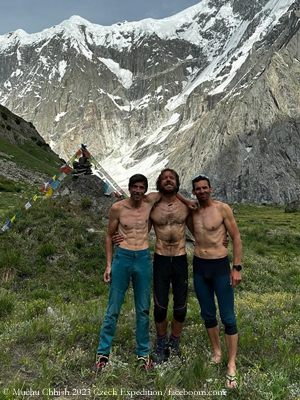
It didn’t take much for the first ascent of the 7,453-meter-high Muchu Chhish in the Karakoram in Pakistan. The two Czechs Tomas Petrecek and Radoslav Groh made it to an altitude of 7,200 meters – without bottled oxygen – but then found the summit zone a too hard nut to crack.
“Tons of mini snowballs everywhere, which you can’t walk through, dig through, climb through. Such a surprise awaited us below the peak of Muchu Chhish, just before the destination of our expedition,” the team let it be known. “For three days we tried to somehow pass through this mass, but in vain. There was no strength left for more attempts, and after careful consideration we preferred to turn it back down.”
Continue reading “Muchu Chhish remains unclimbed, first ascent on Tirich Mir”Summit successes on Broad Peak and Gasherbrum II
The first summit successes of the summer season on the eight-thousanders Broad Peak and Gasherbrum II are reported from the Karakoram in Pakistan. “I’m standing on the summit at 8,051 meters,” Horia Colibasanu announced today via satellite phone from Broad Peak. “It was a strenuous twelve-hour climb. A very long ridge. (A) very difficult summit because I didn’t know which of the ridge tops was the actual summit. I climbed up, I’m tired, I want to start the descent as soon as possible and I hope to get to base camp as soon as possible.” For the 46-year-old Romanian, it was the tenth eight-thousander he scaled without bottled oxygen and without a Sherpa companion.
Continue reading “Summit successes on Broad Peak and Gasherbrum II”Summit successes reported from Nanga Parbat

The first eight-thousander summit successes of commercial expeditions this summer in Pakistan were achieved today on Nanga Parbat. About two dozen climbers reportedly reached the summit of the ninth highest mountain on earth at 8,125 meters. Among them was the Pakistani Sajid Ali Sadpara, who, according to his own information, climbed without bottled oxygen and was part of the rope-fixing team.
For the 25-year-old son of the legendary Muhammad Ali Sadpara (1976-2021), it was the seventh of the 14 eight-thousanders. Sajid climbed six of them without breathing mask: Gasherbrum I and II, as well as Manaslu in 2022, Annapurna, Mount Everest and now Nanga Parbat in 2023. Only on his two ascents of K2 (in 2019 and 2022) did he use bottled oxygen. Sajid’s stated goal is to scale all 14 eight-thousanders without breathing mask.
Continue reading “Summit successes reported from Nanga Parbat”Seven dead climbers recovered in the Indian Himalayas
Ten mountain rescuers of the Indian-Tibetan border police have recovered seven bodies near the seven-thousander Nanda Devi in the Indian Himalayas. They were buried under a metre and a half of snow, a representative of the Indian authorities said. The search for an eighth climber will continue. As reported, the group led by the experienced British expedition leader Martin Moran had been missing since the end of May. The mountaineers had tackled a 6,477-meter-high mountain not far from the 7,434-meter-high Nanda Devi East.
A few days after contact with them had broken off, the crew of a rescue helicopter had discovered five bodies in an avalanche cone on the west ridge of the mountain. The search had to be interrupted due to new heavy snowfalls and therefore high risk of avalanches. Moran Mountain had contradicted the authorities’ accusation that the group had made their way to the unclimbed six-thousander without permission. According to the British expedition operator, the permit applied to all peaks which could be reached from Nanda Devi East Base Camp.
Continue reading “Seven dead climbers recovered in the Indian Himalayas”Nirmal Purja: “I still want to summit all Pakistani 8000ers before the end of July”
Nirmal, called “Nims” Purja has not lost his optimism yet. “We are making progress, the project is still on and I will complete it within my seven-month goal,” the 36-year-old Nepalese posted on Twitter these days. In seven months Nims wants to have scaled all 14 eight-thousanders. In the spring season in Nepal everything went according to plan. Within a month and a day he stood on the summits of six eight-thousanders: Annapurna (23 April), Dhaulagiri (12 May), Kangchenjunga (15 May), Mount Everest (22 May), Lhotse (22 May), Makalu (24 May). The last three summits he completed within 48 hours and 30 minutes. He ascended with his Sherpa team with bottled oxygen via the normal routes. They were flown to the different base camps by helicopter.
Two rescues
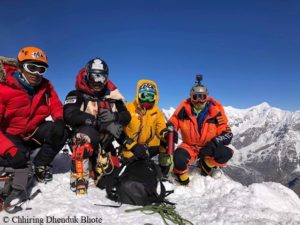
But Purja did not only make headlines with his ascents. On Annapurna, he belonged to the Nepalese who laid the fixed ropes up to the summit. Then he took part in the rescue of the Malaysian mountaineer Wui Kin Chin. Nims and the other rescuers managed to bring Chin from over 7,000 meters from the mountain, but he died a few days later in a hospital in Singapore. On Dhaulagiri, Purja and his companions were the only climbers to reach the summit this spring – despite bad weather. On Kangchenjunga, Nims tried to rescue two Indian climbers who, completely exhausted, had run out of oxygen when they descended. Both died. Most of the headlines, however, were brought to the former soldier of the British Gurkha regiment by the photo he took on 22 May on the summit ridge of Everest. The picture, which showed a long queue on the narrow ridge, went around the world.
Actually, Nims Purja wanted to be now already in Pakistan – for the second phase of his “14/7 Project Possible”: this summer he wants to scale the five eight-thousanders of Pakistan. But he had to postpone his departure because he still lacks money to continue his project. Nims has already taken out a second mortgage on his house in Great Britain. He collects donations via crowdfunding (anyone who wants to support him can do so here – click on the link!). I sent Purja some questions. Here are his answers.
Nims, you stood on the summit of six eight-thousanders in Nepal this spring and were right on schedule with your “Project Possible”. You had to fight the most on Dhaulagiri. How much risk did you have to take?
Continue reading “Nirmal Purja: “I still want to summit all Pakistani 8000ers before the end of July””